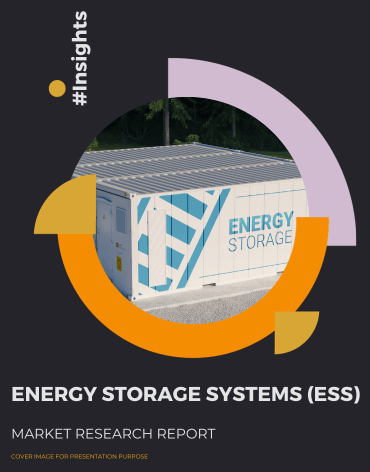Global ESS Battery Market to Reach USD 3.65 billion by 2029

The energy storage systems (ESS) industry has witnessed remarkable growth and transformation in recent years, becoming an integral part of the modern energy landscape. As the world transitions towards cleaner and more sustainable sources of energy, ESS technologies have emerged as a crucial component in optimizing energy use, enhancing grid stability, and enabling the integration of renewable energy sources. This blog post explores the evolving ESS industry, SWOT analysis, its key drivers, applications, and its role in shaping the future of energy.
1 . The Driving Forces Behind ESS Growth:
Several factors have contributed to the rapid expansion of the ESS industry:
Renewable Energy Integration: With the increasing adoption of solar and wind power, energy storage has become essential to balance intermittent energy generation. ESS systems store excess energy during periods of high generation and release it during low production, ensuring a continuous and reliable power supply.
Grid Stability and Resilience: ESS technologies stabilize electrical grids by providing frequency regulation, reducing the risk of blackouts, and offering backup power during grid failures. This is particularly important as modern societies rely heavily on uninterrupted electricity supply.
Energy Cost Reduction: Commercial and industrial users deploy ESS solutions for peak shaving, allowing them to reduce electricity costs by discharging stored energy during peak demand periods. Additionally, the arbitrage of buying low-cost electricity and selling it when prices are high can be a revenue-generating strategy.
Environmental Sustainability: The transition to cleaner energy sources aligns with environmental goals. ESS systems enable the effective use of renewable energy, reducing greenhouse gas emissions and decreasing reliance on fossil fuels.
2 . SWOT Analysis of the ESS Battery Market:
Strengths:
Reliability: ESS battery systems are known for their high reliability, ensuring a stable power supply. For example, they can provide backup power during grid outages, such as in hospitals and data centers.
Efficiency: ESS batteries can efficiently store and discharge energy, making them valuable for optimizing energy usage in residential and commercial settings. For example, they can store excess solar energy during the day for use at night.
Environmentally Friendly: ESS batteries can help reduce greenhouse gas emissions by enabling the integration of renewable energy sources like solar and wind. This aligns with sustainability goals and environmental regulations.
Scalability: ESS systems can be easily scaled up or down to match energy storage needs, from small residential installations to large utility-scale projects. This flexibility allows customization for various applications.
Weaknesses:
High Initial Costs: ESS battery systems often come with a significant upfront investment, making them less accessible to some residential and small business customers.
Limited Lifespan: Battery systems have a finite lifespan and degrade over time, requiring replacement or maintenance. This ongoing cost can be a disadvantage, particularly for large-scale installations.
Energy Density: Current battery technologies have limitations in terms of energy density, meaning they may not store as much energy as other energy storage methods like fossil fuels.
Dependence on Raw Materials: Many battery technologies, such as lithium-ion, depend on specific raw materials like lithium and cobalt. Supply chain disruptions and price fluctuations can affect availability and costs.
Opportunities:
Renewable Energy Integration: ESS battery systems can play a pivotal role in integrating renewable energy sources into the grid. With increasing focus on clean energy, this presents a significant opportunity.
Energy Management Services: ESS systems can provide grid services like peak shaving, load leveling, and frequency regulation, offering revenue opportunities for owners and operators.
Innovation and Technological Advancements: Ongoing research and development can lead to improved battery technologies, including higher energy density, longer lifespan, and faster charging, opening up new markets and applications.
Electric Vehicles (EVs): The growth of the EV market presents opportunities for ESS battery manufacturers to diversify and supply batteries for electric cars and associated charging infrastructure.
Threats:
Competition: The energy storage market is highly competitive, with various technologies and companies vying for market share. New entrants and established players can pose a threat to existing businesses.
Regulatory Changes: Changes in regulations and policies, such as reductions in subsidies or incentives for energy storage, can impact the economic viability of ESS systems.
Technological Obsolescence: Rapid advancements in energy storage technologies may render existing systems obsolete, leading to the need for costly upgrades or replacements.
Supply Chain Disruptions: As mentioned earlier, dependence on specific raw materials and global supply chains can lead to disruptions, impacting production and costs.
3 . ESS Battery Market Forecast:
The global Energy Storage System (ESS) Battery market, as of 2022, was valued at $2,875.6 million and is expected to reach $3,651.8 million by 2029, experiencing a Compound Annual Growth Rate (CAGR) of 3.4% during the forecast period from 2023 to 2029. This growth projection takes into account the impact of the COVID-19 pandemic and the Russia-Ukraine conflict on market sizes.
In 2019, the major players in the Battery Energy Storage System (ESS) market were ranked as follows: Samsung SDI held the top position, followed by LG Chem, Fluence, Hitachi, and Kokam. Collectively, these top five players accounted for approximately 51% of the total revenue market share in the Global Battery Energy Storage System (ESS) market in 2019.
4 . ESS Battery Applications
Energy Storage Systems (ESS) batteries have a wide range of applications across various industries and sectors. Here are some common applications of ESS batteries with examples for each:
Renewable Energy Integration:
- Example: ESS batteries are used to store excess energy generated by wind turbines and solar panels during periods of high renewable energy production. This stored energy can be discharged during periods of low production or high demand, providing a consistent and reliable power supply.
Grid Stabilization and Frequency Regulation:
- Example: ESS batteries can help stabilize the electrical grid by providing rapid-response frequency regulation. They can inject or absorb power within milliseconds to maintain grid stability, preventing blackouts or brownouts.
Peak Shaving:
- Example: Commercial and industrial facilities use ESS batteries to reduce peak demand charges. During periods of high electricity demand, the battery system discharges power to supplement the grid supply, lowering electricity costs.
Uninterruptible Power Supply (UPS):
- Example: Data centers, hospitals, and critical infrastructure rely on ESS batteries to provide immediate backup power in case of grid failures. This ensures continuous operation and data protection.
Residential Energy Storage:
- Example: Homeowners install ESS batteries to store excess energy from their rooftop solar panels. This stored energy can be used during the evening or during grid outages, reducing electricity bills and providing backup power.
Microgrids:
- Example: Remote communities, military bases, and industrial facilities use ESS batteries within microgrids to achieve energy independence. The batteries can balance power generation and consumption, improving grid reliability.
Electric Vehicle (EV) Charging Infrastructure:
- Example: Fast-charging stations for electric vehicles incorporate ESS batteries to provide high-power charging quickly. These batteries ensure that charging stations can meet the demands of multiple EVs simultaneously.
Energy Arbitrage:
- Example: Energy market participants can buy electricity when prices are low and store it in ESS batteries. They can then sell the stored electricity back to the grid when prices are high, profiting from the price differential.
Backup Power for Telecommunications:
- Example: Cellular towers and communication infrastructure rely on ESS batteries to maintain continuous connectivity in the event of power outages or emergencies.
Remote and Off-Grid Applications:
- Example: Remote areas and off-grid installations, such as remote weather stations or remote research facilities, use ESS batteries to store and manage energy generated from sources like wind, solar, or diesel generators.
Load Balancing in Manufacturing:
- Example: Manufacturing facilities use ESS batteries to balance the electricity load during peak production times. This can help reduce electricity costs and avoid penalties for exceeding contracted power levels.
Emergency Services and First Responders:
- Example: Fire stations, police stations, and emergency medical services use ESS batteries to ensure uninterrupted power during emergencies, natural disasters, or power grid failures.
5 . ESS Battery Technological Advancements:
The ESS industry continues to evolve with ongoing research and development efforts. Promising advancements include:
New Battery Chemistries: Researchers are exploring alternative battery chemistries that offer higher energy density, longer lifespans, and faster charging times, addressing some of the limitations of existing technologies.
Energy Management Systems: Intelligent energy management systems are becoming increasingly sophisticated, enabling optimized energy storage and distribution.
Energy Storage Software: Advanced software solutions are being developed to predict and manage energy consumption, enhancing the efficiency and performance of ESS systems.
Second-Life Batteries: Used EV batteries, which may have reduced capacity for vehicle use, are being repurposed for stationary energy storage applications.
6 . Related Market Research Reports
Energy Storage Software Market
Lithium Battery Market
Lead Acid Battery Market
Sodium Sulfur (NaS) Batteries Market
Residential Energy Storage Market






